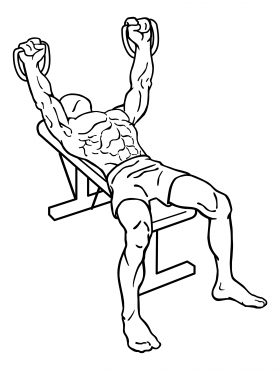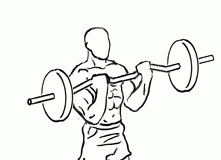Last Updated on September 30, 2022
The incline bench press is a classic exercise for building upper chest and shoulder strength. When you add resistance bands, you take the workout to the next level, introducing variable resistance that targets the chest, biceps, and stabilizing muscles in ways traditional weights can’t. We will explore the benefits, proper technique, variations, and tips for getting the most out of the incline bench press with bands.
Why Add Bands to the Incline Bench Press?
Resistance bands offer several advantages over traditional weights:
- Variable Resistance: Unlike weights, bands provide resistance that increases as you stretch them. This means the intensity grows as you push the bands upward, activating your muscles through a full range of motion.
- Stabilizer Muscle Engagement: Bands require greater stability. Your body works harder to maintain balance, engaging the core and smaller muscle groups that are often underutilized.
- Versatility: Resistance bands are portable and adaptable, allowing you to adjust the level of difficulty by choosing different band thicknesses or doubling up the bands.
- Joint-Friendly: Bands offer a smooth motion, reducing the risk of joint strain compared to heavy weights. They are ideal for people recovering from injuries or looking for a low-impact option.
Incorporating bands in your incline bench press routine can help build strength, increase muscle endurance, and add variety to your workout program.
How to Perform the Incline Bench Press with Bands
Here’s a step-by-step guide to executing this exercise with perfect form:
- Setting Up the Bench and Bands
- Start by setting an incline bench at a 30-45 degree angle. This angle targets the upper chest muscles effectively.
- Securely fasten the resistance band under the legs of the bench, ensuring it is stable and won’t move during your workout. The band should be positioned near your head so that you have a direct line of resistance when you press upward.
- Use a band with the appropriate level of resistance for your strength level. Beginners may start with lighter bands, while advanced lifters can use thicker bands or multiple bands for more resistance.
- Getting into Position
- Lie back on the incline bench with your feet flat on the floor. Ensure your feet are firmly planted to stabilize your movements and support your lower back throughout the exercise.
- Grasp one end of the band in each hand. Your hands should start at chest level, palms facing forward, with the band resting against your palms.
- Maintain a neutral grip and engage your core to prevent arching your lower back during the movement. Your head, upper back, and glutes should remain in contact with the bench.
- Pressing the Bands
- Begin the pressing motion by extending your arms upward. Push the bands away from your chest until your arms are fully extended but not locked out.
- Focus on squeezing your chest muscles as you press the bands upward. The peak contraction happens when your arms are almost fully extended, so maintain control and pause briefly at the top.
- Returning to the Starting Position
- With a slow and controlled motion, return your hands to the starting position at chest level. Avoid allowing the bands to pull your arms down too quickly. The key is to maintain control throughout the descent, ensuring that your muscles stay engaged.
- Repeat for the desired number of repetitions, typically 8-12 for strength training. For muscle endurance or hypertrophy, consider 12-15 reps with lighter resistance.
Tips for Optimal Results
- Focus on Form: Maintaining proper form is crucial, especially when using bands. Keep your shoulders back and down to avoid over-stressing your shoulder joints.
- Engage Your Core: To stabilize your body, engage your core throughout the movement. A strong core helps prevent your back from arching and ensures efficient power transfer.
- Control the Eccentric Phase: The lowering (eccentric) phase is just as important as the pressing (concentric) phase. Lower the bands slowly to maximize muscle activation and prevent injury.
- Warm Up Properly: Warming up before performing band exercises is essential. Dynamic stretches and light cardio can prepare your muscles and joints, reducing the risk of injury.
Common Mistakes to Avoid
- Arching the Lower Back Too Much
- It’s easy to arch your lower back to compensate when pressing the bands, but this can strain your spine. Engage your core and ensure your lower back stays pressed against the bench.
- Using Too Much Resistance Too Soon
- Start with a manageable band resistance level. Overloading with bands that are too thick can compromise your form and lead to injury.
- Rushing Through Reps
- The goal is to maintain control throughout the exercise. Rushing through reps decreases the time under tension, reducing the effectiveness of the workout. Focus on a slow, controlled pace.
Benefits of the Incline Bench Press with Bands
This exercise provides numerous benefits that can enhance your overall upper-body strength and aesthetics:
- Chest Development: The incline position emphasizes the upper part of the chest (pectoralis major), giving a fuller, more defined look.
- Biceps Activation: The resistance bands engage the biceps as stabilizers, giving them an indirect workout.
- Increased Muscle Tension: Bands maintain constant tension throughout the movement, increasing muscle fiber recruitment and stimulating muscle growth.
- Improved Balance and Coordination: The unstable nature of bands forces you to engage stabilizing muscles, improving balance and functional strength.
Variations to Challenge Your Routine
Once you’ve mastered the basic incline bench press with bands, try these variations to keep your workouts engaging:
- Single-Arm Incline Bench Press with Bands
- Perform the press with one arm at a time. This variation challenges your stability and enhances unilateral strength, helping to correct muscle imbalances.
- Alternating Incline Bench Press with Bands
- Alternate between pressing with the left and right arms. This approach increases core engagement and further tests your balance and coordination.
- Tempo Incline Bench Press
- Slow down the eccentric (lowering) phase to a count of 3-5 seconds while maintaining a quick 1-second press upwards. This increases time under tension and promotes muscle hypertrophy.
- Incline Bench Press with Pulses
- At the top of the movement, perform small pulses for 5-10 reps before returning to the starting position. Pulses intensify the peak contraction, further targeting the chest and biceps.
- Incline Bench Press Superset with Push-Ups
- Combine the incline bench press with resistance bands and push-ups in a superset for a comprehensive chest workout. After completing a set of presses, immediately move into a set of incline push-ups. This variation increases the volume and intensity, promoting greater muscle fatigue and growth.
Safety Considerations
When performing any exercise with bands, safety is paramount:
- Check the Bands Regularly: Inspect your bands for any signs of wear or tear. A snapped band can cause injury, so replace them if you notice any damage.
- Stabilize the Bands Properly: Ensure the bands are securely anchored under the bench before starting your exercise. A loose or unstable band setup can lead to improper form and potential injuries.
- Avoid Overstretching the Bands: Only stretch the bands within their recommended limits. Overstretching can cause the bands to break or snap back unexpectedly.
Integrating the Incline Bench Press with Bands into Your Workout Routine
The incline bench press with bands can be a versatile addition to any upper-body workout. Here are some ways to incorporate it:
- Strength Routine: Perform 3-4 sets of 8-10 reps with moderate resistance. Focus on maintaining control and maximizing muscle contraction.
- Hypertrophy Routine: Use lighter resistance and aim for 12-15 reps, emphasizing time under tension by slowing down each phase of the lift.
- Circuit Training: Include this exercise in a circuit with other upper-body movements like band rows, push-ups, and lateral raises. This approach targets multiple muscle groups and increases cardiovascular intensity.
- Chest-Focused Workout: Pair the incline bench press with other band exercises like chest flys and resistance band push-ups for a chest-centric workout that maximizes volume.
The incline bench press with bands is an excellent exercise for anyone looking to build and define their chest and biceps while enhancing stability and overall strength. The variable resistance and versatility of bands make this a highly effective movement that can be adjusted to any fitness level. By integrating this exercise into your routine, focusing on proper form, and experimenting with variations, you can elevate your upper-body workouts and see significant improvements in muscle growth and definition.









